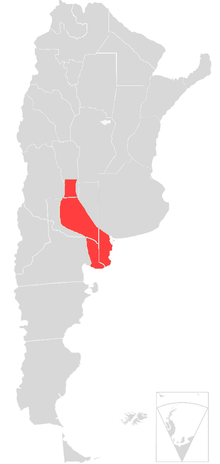
The Semi-arid Pampas, also known as the Dry Pampas, is a temperate grassland ecoregion of south central Argentina.

The Semi-arid Pampas, also known as the Dry Pampas, is a temperate grassland ecoregion of south central Argentina.

The Semi-arid Pampas cover an area of 327,000 square kilometers (126,000 sq mi), including western Buenos Aires Province, southern Cordoba and San Luis Provinces and most of La Pampa Province. The area is, in all, home to no more than a million people, who generally enjoy some of the nation's lowest poverty rates. [1]
The Humid Pampas grassland lies to the east, while the drier Argentine Espinál (thorny) grassland lies to the west. The soil tends to be sandier in this region than to the east, though both regions are characterized by their mostly minimal incline and frequent finger lakes. Generally more similar than not, these two biomes are mostly distinguished by their contrasting rainfall quantities, soil quality and land use; this section of the pampas typically sees about a third less rainfall (700 mm, 27 in) than the humid pampas.

Not unlike the more humid pampas to the east, this area is characterized by its extensive grasslands. This groundcover, however, tends to be closer to long-grass varieties found in the world's steppes. Its landscape punctuated by relatively few trees (mostly imported ombúes, alders and Italian cypresses planted to provide wind breaks or landscaping), the region is home to intermittent shrublands, therein particularly carquejilla and caldén (prized for their medicinal qualities), as well as the shady algarrobo, common to much of Argentina.

In part owing to its sparse landscape and unreliable rains, the area's fauna rather resembles much of neighboring Patagonia's. Perhaps the most common natural inhabitant to the region is the ñandú, or, Darwin's rhea. Nearly ubiquitous to the region in the early 19th century, vast herds were often observed at the time and, indeed, they and their eggs had for centuries provided the Puelches and the area's other indigenous peoples with much of their protein needs. Targeted during successive genocidal campaigns between 1830 and 1880, however, these inhabitants lost most ñandús to massacres by Argentine armies, who believed that in so doing, the indigenous tribes could be starved into surrender. [2]
Nearing extinction by the 1920s, the ñandú herds have recovered substantially and have since then, like the likewise then-nearly extinct pampas deer, been protected by law. Other common fowl include gray hawks, partridges, martins, coots and storks.
The region is also home to pumas, pampas foxes, cavias, maras and other drought-resistant mammals, as well as some also common to North America, like skunks and opossums.
The arrival of British-financed railways to the region in the 1880s brought with it the area's first significant presence of white settlers, some of whom had served in the regiments involved in the Conquest of the Desert and were granted vast tracts of land. Much of the area was subsequently fenced into cattle and sheep ranches, which dominate the region's land use to the present day; area ranchers raise approximately four million cattle (a tenth of Argentina's total production). Since the 1940s, advances in agriculture and crop breeding have allowed for intensive wheat, sunflower, oats and alfalfa cultivation, as well. [3]
Though many of the hydroelectric projects put into place since then have encouraged the development of a scattering of prosperous urban areas like Santa Rosa, La Pampa, some have had unintended consequences to the area's ecological balance. Dams along the Atuel River, for instance, are often allowed to release the rainy season's excess water with little regard to the area around rural Algarrobo del Aguila, La Pampa, causing avoidable inconvenience and disruption of nearby wetlands. [4]

Until recently, the region was the only one in Argentina lacking a national park or natural preserve. In 1971, descendants of La Pampa Province landowners Arminda Roca and Pedro Luro deeded 7,600 hectares (29 mi2) to the provincial government, which opened the park to the public five years later. Though the area would not be designated as fully protected until 1996, this was the first significant move to protect the biome. Today the Luro Park Natural Preserve is the most visited such area in the dry pampas region. [5] In 1977, a 9,900 hectare (38 mi2) parcel in La Pampa Province's southern dry grasslands were set aside as Lihué Calel National Park. [6]
These accomplishments notwithstanding, the area's ecosystem has been under increasing pressure by grazing and irrigation activities, apart from population and economic growth themselves.

In physical geography, a steppe is an ecoregion characterized by grassland plains without closed forests except near rivers and lakes. Steppe biomes may include:

Temperate grasslands, savannas, and shrublands is a terrestrial biome defined by the World Wide Fund for Nature. The predominant vegetation in this biome consists of grass and/or shrubs. The climate is temperate and ranges from semi-arid to semi-humid. The habitat type differs from tropical grasslands in the annual temperature regime and the types of species found here.
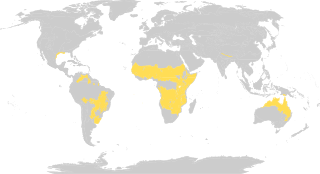
Tropical and subtropical grasslands, savannas, and shrublands is a terrestrial biome defined by the World Wide Fund for Nature. The biome is dominated by grass and/or shrubs located in semi-arid to semi-humid climate regions of subtropical and tropical latitudes. Tropical grasslands are mainly found between 5 degrees and 20 degrees in both North and south of the Equator.
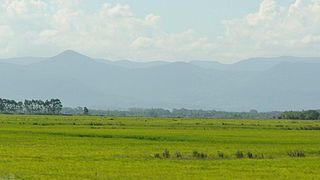
The Pampas, also known as the Pampas Plain, are fertile South American low grasslands that cover more than 1,200,000 square kilometres (460,000 sq mi) and include the Argentine provinces of Buenos Aires, La Pampa, Santa Fe, Entre Ríos, and Córdoba; all of Uruguay; and Brazil's southernmost state, Rio Grande do Sul. The vast plains are a natural region, interrupted only by the low Ventana and Tandil hills, near Bahía Blanca and Tandil (Argentina), with a height of 1,300 m (4,265 ft) and 500 m (1,640 ft), respectively.

La Pampa is a sparsely populated province of Argentina, located in the Pampas in the center of the country. Neighboring provinces are from the north clockwise San Luis, Córdoba, Buenos Aires, Río Negro, Neuquén and Mendoza.

Rangelands are grasslands, shrublands, woodlands, wetlands, and deserts that are grazed by domestic livestock or wild animals. Types of rangelands include tallgrass and shortgrass prairies, desert grasslands and shrublands, woodlands, savannas, chaparrals, steppes, and tundras. Rangelands do not include forests lacking grazable understory vegetation, barren desert, farmland, or land covered by solid rock, concrete, or glaciers.
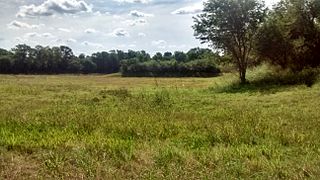
The Humid Chaco is tropical grasslands, savannas, and shrublands ecoregion in South America. It lies in the basin of the Paraná River, covering portions of central Paraguay and northern Argentina, and with a small portion of southwestern Brazil and northwestern Uruguay. The natural vegetation is a mosaic of grasslands, palm savanna, and forest.
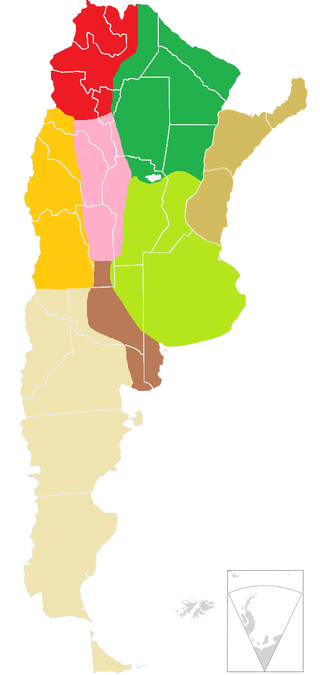
The provinces of Argentina are often grouped into eight geographical regions.

The Humid Pampas is an extensive ecoregion of flat, fertile grassland of loessic origin in Argentina. It has a precipitation average of 900 mm per year, in contrast with the Dry Pampas to the west, which average less than 700 mm.

The puna grassland ecoregion, part of the Andean montane grasslands and shrublands biome, is found in the central Andes Mountains of South America. It is considered one of the eight Natural Regions in Peru, but extends south, across Chile, Bolivia, and western northwest Argentina. The term puna encompasses diverse ecosystems of the high Central Andes above 3200–3400 m.

The Mongolian-Manchurian grassland, also known as the Mongolian-Manchurian steppe or Gobi-Manchurian steppe, in the temperate grassland biome, is an ecoregion in East Asia covering parts of Mongolia, the Chinese Autonomous region of Inner Mongolia, and Northeast China.

The climate of Argentina varies from region to region, as the vast size of the country and wide variation in altitude make for a wide range of climate types. Summers are the warmest and wettest season in most of Argentina, except for most of Patagonia, where it is the driest season. The climate is warm in the north, cool in the center, and cold in the southern parts, that experience frequent frost and snow. Because the southern parts of the country are moderated by the surrounding oceans, the cold is less intense and prolonged than areas at similar latitudes in the northern hemisphere. Spring and autumn are transition seasons that generally feature mild weather.

Lihué Calel National Park is a national park in Argentina, located in the Lihue Calel Department, in the center of La Pampa Province. The area is one of mountain plains and plateaux, and is known for its grass tussocks. The park covers 324 square kilometres, and was established in 1977.
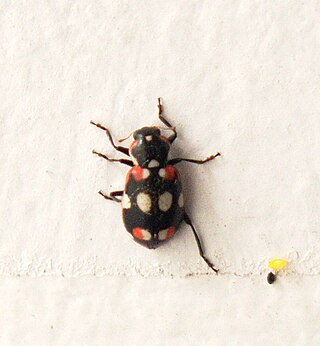
The Environment of Argentina is characterised by high biodiversity.

The Sierras Pampeanas is a geographical region of Argentina.

Mediterranean forests, woodlands and scrub is a biome defined by the World Wide Fund for Nature. The biome is generally characterized by dry summers and rainy winters, although in some areas rainfall may be uniform. Summers are typically hot in low-lying inland locations but can be cool near colder seas. Winters are typically mild to cool in low-lying locations but can be cold in inland and higher locations. All these ecoregions are highly distinctive, collectively harboring 10% of the Earth's plant species.

Due to its vast size and range of altitudes, Argentina possesses a wide variety of climatic regions, ranging from the hot subtropical region in the north to the cold subantarctic in the far south. The Pampas region lies between those and featured a mild and humid climate. Many regions have different, often contrasting, microclimates. In general, Argentina has four main climate types: warm, moderate, arid, and cold in which the relief features, and the latitudinal extent of the country, determine the different varieties within the main climate types.

The Espinal (NT0801) is an ecoregion of dry, thorny forest, savanna and steppe in Argentina. It has been extensively modified by large scale cattle ranching, but remnants of the original flora remain. It is threatened by the advance of the irrigation-based agricultural frontier.

The High Monte is a montane grasslands and shrublands ecoregion in Argentina.